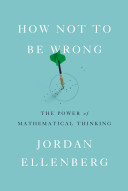The Law of Large Numbers
The game is called who’s the best at flipping coins. It’s pretty simple. You flip a bunch of coins and whoever gets the most heads wins. To make this a little more interesting, though, not everybody has the same number of coins. Some people—Team Small—have only ten coins, while the members of Team Big have a hundred each.
If we score by absolute number of heads, one thing’s for almost sure—the winner of this game is going to come from Team Big. The typical Big player is going to get around 50 heads, a figure none of the Smalls can possibly match. Even if Team Small has a hundred members, the high scorer among them is likely to get an 8 or 9
That doesn’t seem fair! Team Big has got a massive built-in advantage. So here’s a better idea. Instead of scoring by raw number, let’s score by proportion. That should put the two teams on a fairer footing.
But it doesn’t. As I said, if there are a hundred Smalls, at least one is likely to get 8 heads. So that person’s score is going to be at least 80%. And the Bigs? None of the Bigs is going to get 80% heads. It’s physically possible, of course. But it’s not going to happen. In fact, you’d need about two billion players on the Big team before you’d get a reasonable chance of seeing any outcome that lopsided. This ought to fit your intuition about probability. The more coins you throw, the more likely you are to be close to 50-50.
You can try it yourself! I did, and here’s what happened. Repeatedly flipping 10 coins at a time to simulate Small players, I got a sequence of head counts that looked like this:
4, 4, 5, 6, 5, 4, 3, 3, 4, 5, 5, 9, 3, 5, 7, 4, 5, 7, 7, 9 . . .
With a hundred coins, like the Bigs, I got:
46, 54, 48, 45, 45, 52, 49, 47, 58, 40, 57, 46, 46, 51, 52, 51, 50, 60, 43, 45 . . .
And with a thousand:
486, 501, 489, 472, 537, 474, 508, 510, 478, 508, 493, 511, 489, 510, 530, 490, 503, 462, 500, 494 . . .
Okay, to be honest, I didn’t flip a thousand coins. I asked my computer to simulate coin flips. Who has time to flip a thousand coins?
One person who did was J. E. Kerrich, a mathematician from South Africa who made an ill-advised visit to Europe in 1939. His semester abroad quickly turned into an unscheduled stint in an internment camp in Denmark. Where a less statistically minded prisoner might have passed the time by scratching the days on the cell wall, Kerrich flipped a coin, 10,000 times in all, keeping track of the number of heads as he went. His results looked like this:
As you can see, the fraction of heads converges inexorably toward 50% as you flip more and more coins, as if squeezed by an invisible vise. You can see the same effect in the simulations. The proportions of heads in the first group of tries, the Smalls, range from 30% to 90%. With a hundred flips at a time, the range narrows: just 40% to 60%. And with a thousand flips, the range of proportions is only 46.2% to 53.7%. Something is pushing those numbers closer and closer to 50%. That something is the cold, strong hand of the Law of Large Numbers. I won’t state that theorem precisely (though it is stunningly handsome!), but you can think of it as saying the following: the more coins you flip, the more and more extravagantly unlikely it is that you’ll get 80% heads. In fact, if you flip enough coins, there’s only the barest chance of getting as many as 51%! Observing a highly unbalanced result in ten flips is unremarkable; getting the same proportional imbalance in a hundred flips would be so startling as to make you wonder whether someone has mucked with your coins.
Notes:
Folksonomies: mathematics statistics
Taxonomies:
/hobbies and interests/collecting/stamps and coins (0.633568)
/sports/baseball (0.436334)
/sports/gymnastics (0.331165)
Keywords:
coins (0.979101 (positive:0.014210)), Team Big (0.843330 (positive:0.345099)), heads (0.842588 (negative:-0.464384)), Large Numbers (0.755562 (positive:0.313796)), massive built-in advantage (0.736530 (neutral:0.000000)), typical Big player (0.735156 (neutral:0.000000)), statistically minded prisoner (0.717442 (negative:-0.350340)), J. E. Kerrich (0.711768 (neutral:0.000000)), highly unbalanced result (0.711444 (negative:-0.715967)), flips (0.655839 (negative:-0.334487)), coin flips (0.647948 (neutral:0.000000)), fairer footing (0.639643 (positive:0.609568)), high scorer (0.639446 (negative:-0.390443)), better idea (0.638063 (positive:0.745776)), unscheduled stint (0.627222 (negative:-0.364983)), absolute number (0.625696 (neutral:0.000000)), head counts (0.625369 (negative:-0.261140)), raw number (0.625018 (negative:-0.595975)), ill-advised visit (0.623212 (negative:-0.241067)), reasonable chance (0.622353 (positive:0.531354)), Team Small (0.621148 (neutral:0.000000)), proportional imbalance (0.620911 (negative:-0.462804)), internment camp (0.620460 (negative:-0.364983)), South Africa (0.620265 (negative:-0.241067)), invisible vise (0.619613 (negative:-0.486868)), cell wall (0.618948 (negative:-0.350340)), person’s score (0.618117 (negative:-0.339625)), strong hand (0.617187 (positive:0.233035)), Smalls (0.616088 (negative:-0.502447)), Small players (0.614837 (negative:-0.307357))
Entities:
Bigs:Organization (0.704210 (negative:-0.677800)), J. E. Kerrich:Person (0.673070 (negative:-0.325273)), Smalls:Person (0.560717 (negative:-0.502447)), Team Small:Company (0.519599 (neutral:0.000000)), Europe:Continent (0.422039 (negative:-0.241067)), Denmark:Country (0.412549 (negative:-0.364983)), South Africa:Country (0.375601 (negative:-0.241067)), 80%:Quantity (0.375601 (neutral:0.000000)), 50%:Quantity (0.375601 (neutral:0.000000)), 46.2%:Quantity (0.375601 (neutral:0.000000)), 53.7%:Quantity (0.375601 (neutral:0.000000)), 30%:Quantity (0.375601 (neutral:0.000000)), 40%:Quantity (0.375601 (neutral:0.000000)), 51%:Quantity (0.375601 (neutral:0.000000)), 60%:Quantity (0.375601 (neutral:0.000000)), 90%:Quantity (0.375601 (neutral:0.000000))





